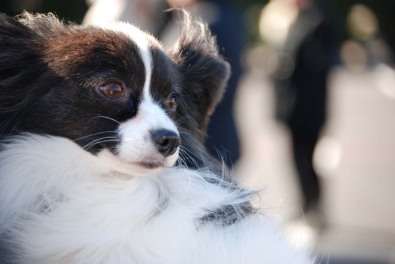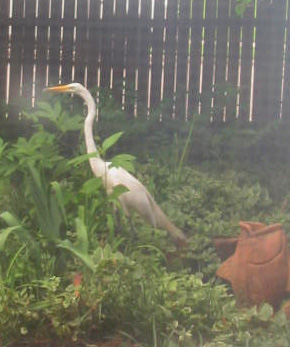Kids with Autism and Assistance Dogs
January 31, 2008
Photo by Kellie Snider, Copyright 2008
Background Music: Got to Be More Careful
by John Cleary and the Absolute Monster.
I have become concerned about the recent trend to use dogs to “supervise” children with autism. Some people have stories about wonderful things that happened when children were paired with assistance dogs. This is great for them, but the experiences are not necessarily universal.
Because autism is a spectrum disorder and the abilities and skills of one person with autism may vary dramatically from those of another, there are some for whom a dog may be an excellent choice as a pet and companion, if the person is interested in having a dog. However, for many of these high functioning people, so long as autism is the only disability present, there is no real need for an assistance animal since they are capable of caring for themselves. These people should be included in deciding whether they will get a dog or not, and what kinds of training the dog will receive.
The children with autism that are given assistance dogs are often not capable of participating in the decision to get a dog, nor in the training of a dog. In some cases, through no fault of the child, the animal may be mistreated. This is not because the child is “bad”, of course, but only because he isn’t capable of providing the kinds of guidance and care a dog needs, and because he may not understand when the dog is being hurt. Despite the romantic notion that dogs understand that children with autism are different and remain gentle with them, it is not clear that this is true. Although there is an idea in the culture these days that dogs are a lot like people with autism, there is no evidence that this is true, either.
For children with autism the assistance dog is usually placed in the family when it is still a young puppy and the parents are responsible for most of his/her training. Unfortunately the parents of children with autism are often overwhelmed with the enormous responsibility of raising a child with autism and adding the responsibility of training a service dog is asking a lot of them, even if they are initially quite motivated to do it.
Perhaps a greater concern is that among the diagnostic symptoms of autism is an absence of social interest. In other words, people with autism may not read facial expressions or body language appropriately or at all. They often do not like being touched. They do not make eye contact or look directly at other people or animals. They may respond in abnormal or unusual, sometimes dangerous, ways to tastes, tactile stimuli (whether pain or seemingly mild sensations), sounds, smells, and visual stimuli. They often do not care about animals, and may not like being touched by animals.
Unless and until a child has exhibited a positive response to animals on multiple occasions, an assistance dog is not recommended. Animals may be used in various kinds of therapy, including behavioral treatment to help the child learn to tolerate animals, under supervision for limited periods of time. Often pairing children with autism with assistance dogs is done because it makes grown-ups who do not have autism feel good.
Last but not least, the life of an assistance dog is challenging. For most assistance dogs the positive relationship with his partner is what keeps him going. It is difficult to forge interpersonal relationships with children with autism. For the dog assisting a child with moderate to severe autism, sometimes this social reinforcement is not available. It is up to other family members to ensure that the dog’s needs are met and that nothing happens toward which he may respond with aggression or fear.
If a dog is to be placed in a family to help a child with autism, the parent must always be present and responsible for the dog during every interaction he has with the child. This is for the protection of the dog as well as of the child. It is an unfair and potentially tragic mistake to assume a dog can be a nanny or a supervisor for any child, especially one with autism. Likewise it is unfair to expect a child with autism to be responsible for the safety and well-being of an assistance animal.
If a parent of a child with autism wants to get a dog, that is great, but the adoption of a dog into any family must be taken seriously. Talk with others with similar experiences, determine what the dog’s needs are and how those will meld with those of the adoptive family. Will the family have the time, wherewithal and money to care for a dog in addition to a child with autism? Caring for a child with autism is expensive. Is there enough money in the family to care for a dog’s needs should he become ill or injured?
If a dog is to be placed with a family of a child with autism there should be a guaranteed return policy. No matter what, the family must be able to return the dog to his breeder or assistance dog group if it doesn’t work out for any reason.
It is simply not safe to entrust a child with autism to a dog’s care unless an adult is in charge and on task in overseeing all interactions. Nor is it safe to entrust a dog with a child with autism except under adult supervision. A dog adopted into the family must be trained, and assistance tasks may be helpful, but perhaps not as helpful as solid manners training.
Kellie Snider, BS, MS
Board Certified Associate Behavior Analyst
Speaking up for those who have no choice.
Nature in the City
June 7, 2007
Last week I noticed that the fish in my water garden were not eating. This was not normal. Each spring as they get their eyes open after a long winter’s semi-dormancy it takes them a while to begin to come out and beg like the little piggies goldfish can be, but they always eat. I had finally gotten my pond switched from comet goldfish to fantails.
Each day I would go out and feed them, and a little while later I’d go out and look and the food would be gone, so I knew they were eating- they were just doing it clandestinely. But over the course of a few days more and more food was left. Finally it appeared that all of the food was still there even several hours later. I got the net and moved the plants around, but I couldn’t find any fish. Not one. Not even the small ones that had yet to get their colors. The adults were brightly colored fantail goldfish- red or calico. They are easy to see, but there was no one in the pond. A few had died during a series of hail storms a couple of weeks earlier, but while he’d had an unusual amount of rain for this part of Texas, we’d had no more hail. There were no signs of the destruction made when raccoons raid a pond. My dogs would never bother fish- what? And get their faces wet? I don’t think so.
Fish can be surprisingly good hiders even in a backyard pond, but a couple more days went by and I was certain all of the fish were gone. I put mosquito dunks in the pond.
Our master bathroom overlooks the roof of the back part of our house. One morning I pulled back the curtain to get into the shower and there outside the window stood a massive egret. He was easily three feet tall, perhaps taller, and brilliantly white with a sharp yellow beak pointed down to the pond below. The flesh in the soft throat fluttered though the rest of him was stone still, looking. (Sorry, Charlie… you already cleaned out that fridge!) In a moment he took three strides to the crest of the roof, positioned himself to get a better look. One would think that an animal with legs that long would be awkward, but he moved smooth and graceful. He moved as he had to move if he were not to alert the fish.
I quietly called my husband and he came and we both got a good look at him. He went and looked him up online while I showered. The egret stood within 15 feet of me in my shower for about five minutes and I got a very good look at a very magnificent creature. This was a Great Egret, also known as a white heron.
That was last week. Last night I was given some mosquito fish for my pond from a ponder in the area. This morning when I went to the back door to let the dogs out, there stood the egret, on the ground in the thick plants near the pond. I ran for my camera making the dogs wait. To give you an idea of the size of this bird, the terra cotta fish pot on the right side of the picture measures 16″ tall and is sitting on a flat rock that is 4″ tall. The area where the egret is standing is flat ground in the garden. His legs are as long as his neck.
An instant after this photograph was taken the egret flew away. His wing span, which, if he was 3 feet tall would have measured 5 feet, seemed to fill my small back yard.
I had not purchased any more goldfish because I knew he would eat them. Now I am considering stocking the pond just for our urban egret.
For more information on the Great Egret, including a recording of their vocalizations, visit the Cornell University website: http://www.birds.cornell.edu/AllAboutBirds/BirdGuide/Great_Egret_dtl.html#sound


